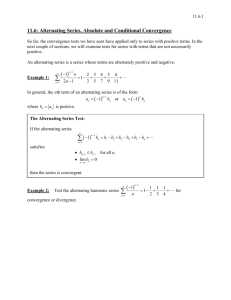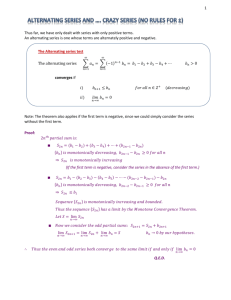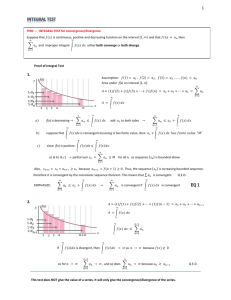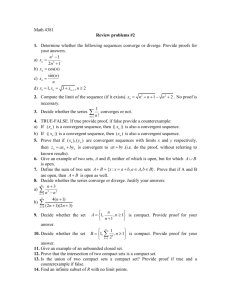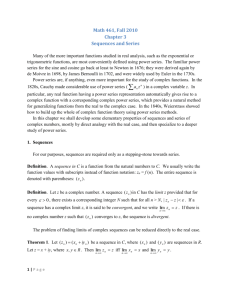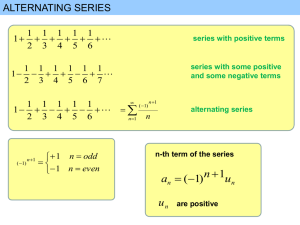Section8.4notes
advertisement
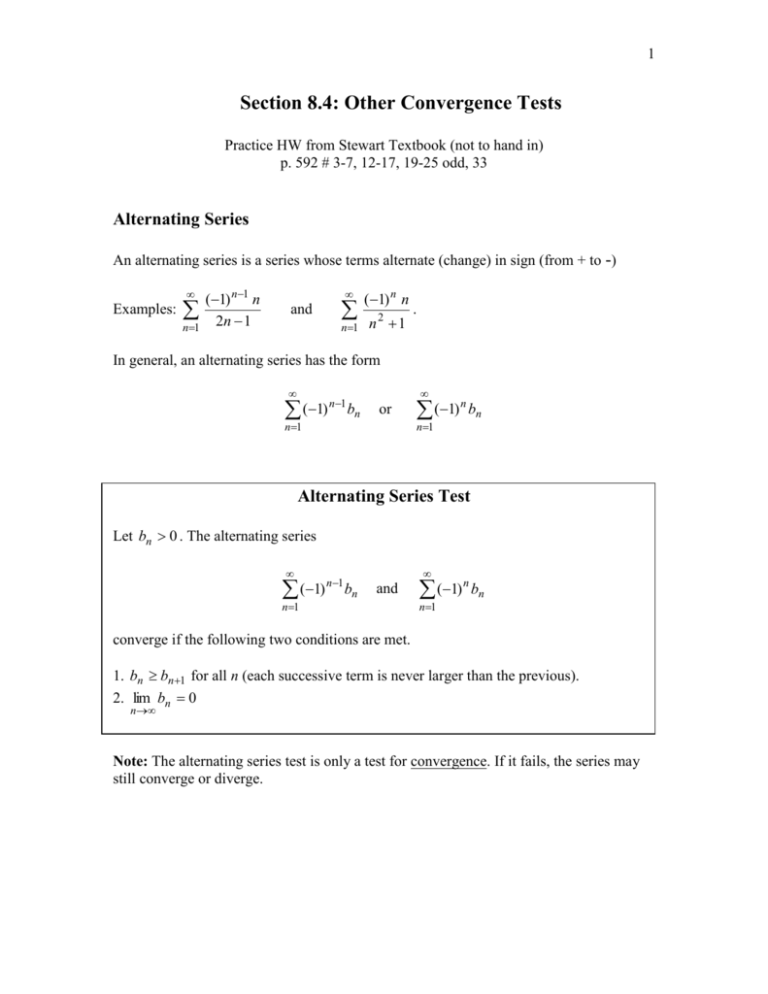
1 Section 8.4: Other Convergence Tests Practice HW from Stewart Textbook (not to hand in) p. 592 # 3-7, 12-17, 19-25 odd, 33 Alternating Series An alternating series is a series whose terms alternate (change) in sign (from + to -) Examples: n1 (1) n1 n 2n 1 and (1) n n n 1 n2 1 . In general, an alternating series has the form (1) n1 bn or (1) n bn n1 n 1 Alternating Series Test Let bn 0 . The alternating series (1) n1 bn and n 1 (1) n bn n1 converge if the following two conditions are met. 1. bn bn1 for all n (each successive term is never larger than the previous). 2. lim bn 0 n Note: The alternating series test is only a test for convergence. If it fails, the series may still converge or diverge. 2 Example 1: Determine the convergence or divergence of the series (1) n n n 1 n2 1 Solution: █ 3 Example 2: Determine the convergence or divergence of the series (1) n1 n 2n 1 n1 Solution: █ 4 Estimating the Sum of a Convergent Alternating Series Most of the series test (geometric series is one exception) so far have been designed to only indicate whether a given series converges or diverges. When the series is convergent, no method for find the sum (the value the series converges to) has been given. However, it is possible to estimate the sum of the series to a designated accuracy. Here, we present a method for doing this that is designed for alternating series (note others exist for other types of series – for example, see p. 583 for a method involving the integral test). Error Estimate for a Convergent Alternating Series Let s (1) n bn1 be the sum of a convergent alternating series. If s n1 = the sum of the first n – 1 terms of the series and let Rn1 = the difference between s and s n1 . Then Error between sum and | error | | Rn1| | | s s n1 | bn partial (n - 1) th sum Note 1. Approximating the sum up to a certain number of decimal places means the digits of approximation and the sum agree up to amount of decimal places. In general, for error estimation, this means that to agree up to n decimal places, | error | 00 0 9 n zeros 2. Once the number of terms needed in the series to approximate the sum to the desired accuracy is found, Maple can be useful for getting the approximation. 5 Example 3: How many terms do we need to generate for (1) n n n2 1 for | error | 0.001 . n1 Solution: █ 6 Example 4: Approximate the sum of the following series to 3 decimal places. (1) n1 n1 n 2 1 1 1 1 1 4 9 16 25 Solution: First, note that this is a convergent alternating series since by the alternating series test 1 1 1 1 4 9 16 25 1 2. lim 2 0 . n n 1. 1 In order to approximate the sum of the series to 3 decimal places, we must sum enough terms of the series so that | error | bn 0.0009 To find this, we first find the approximate value of n where bn 1 n2 following Maple solve command can be used to find this value of n. 0.0009 . The > solve(1/n^2 = 0.0009, n); -33.33333333, 33.33333333 Thus, n 33.3 (we only need consider the positive solution here). Thus, for 1 bn 2 0.0009 , we take n = 34. Thus, we need to add the first n – 1 = 33 terms of the n series to guarantee the desired accuracy. The following Maple commands will display and compute this sum: > Sum((-1)^(n-1)/n^2, n = 1..33); 33 S n=1 (-1)(n - 1) n2 > evalf(value(%)); 0.8229122698 Hence, to 3 decimal places, (1) n1 n1 n2 0.822 █ 7 Absolute Convergence Definition: A series convergent. an is called absolutely convergent if the series an is Fact: If a series is absolutely convergent, then the series is itself convergent. Sometimes, it can be easier to determine that a series is absolutely convergent. Example 5: Determine if the series (1) n1 n1 n3/ 2 is absolutely convergent. Solution: █ 8 Example 6: Determine if the series n 1 (1) n1 is absolutely convergent. n 1 Solution: █ 9 Note: A series an that is not absolutely convergent may still be convergent. Example 7: Demonstrate that the series n 1 (1) n1 , while not absolutely convergent, is n 1 still convergent. Solution: █
